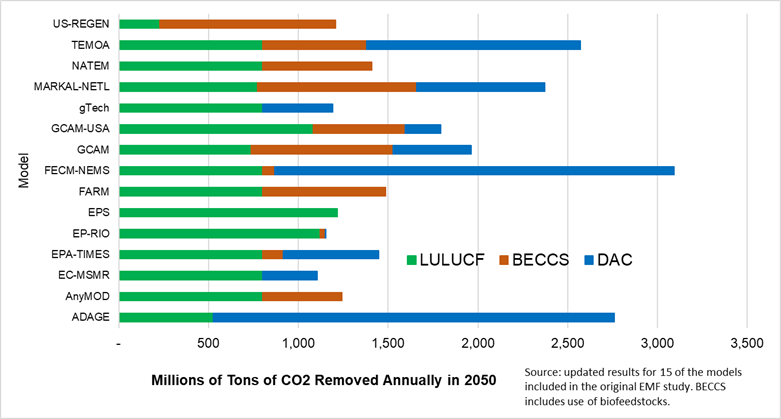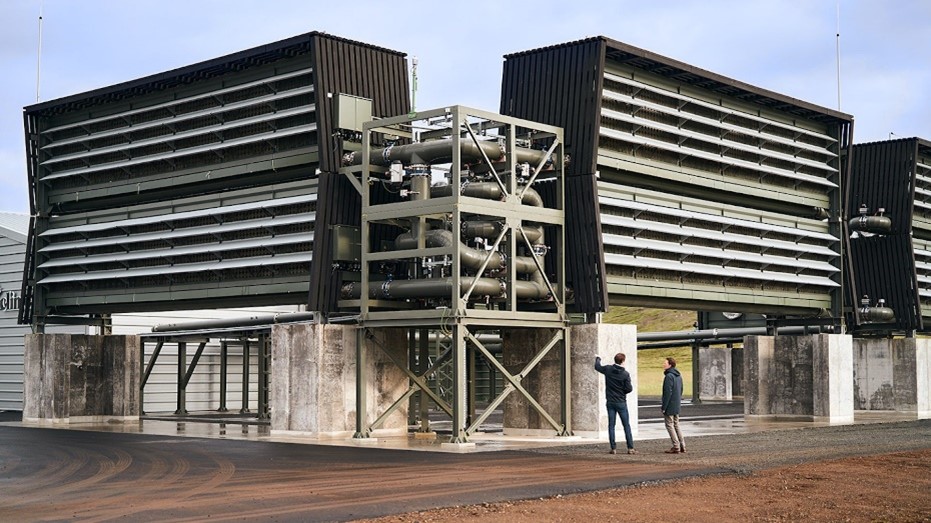
Direct Air Capture: Savior, Distraction, or Trojan Horse? Decoding the Controversies
In the disputatious field of climate policy, Direct Air Capture (DAC) is an exceptionally controversial policy and technology option. DAC is one of a suite of methods for extracting carbon dioxide (CO2), the most common greenhouse gas (GHG), from the atmosphere. According to the Intergovernmental Panel on Climate Change (IPCC), Carbon Dioxide Removal (CDR) will almost certainly be necessary to prevent the worst effects of climate change, and DAC is a primary option for implementing CDR. But in the eyes of some, DAC is nothing more than an expensive boondoggle and, worse, a backdoor for continued production and use of fossil fuels.
The potential importance of DAC to climate policy is illustrated by a recent Energy Modeling Forum (EMF)-sponsored study exploring how the major North American economies – Canada, Mexico, and the United States – can achieve net zero carbon emissions. OnLocation participated in the study using the version of the National Energy Modeling System (NEMS) that is customized for the U.S. Department of Energy’s Office of Fossil Energy and Carbon Management (FECM). The FECM version of NEMS incorporates enhancements for analyzing climate policy scenarios, including DAC; industrial sector carbon capture, utilization, and storage (CCUS); and a limited version of biomass cofiring and carbon capture and storage (BECCS).
The EMF exercise involved 16 energy models running common scenarios (the results are summarized for the United States in a recent paper). In this blog post, we examine one specific factor, reliance on DAC technology to achieve net zero emissions, which is especially prominent in the FECM-NEMS forecast. Scrutinizing the role of DAC provides a window into one of the most important and contentious elements of the debates over climate policy.
Residuals and Overshoots
The starting point is understanding the scale of the climate challenge that decision-makers are facing. The IPCC recently completed its sixth assessment cycle with a capstone report that synthesizes the current scientific consensus on the climate outlook. The IPCC found that severe climate impacts are probable because the key threshold — an increase in global temperatures of 1.5C relative to pre-industrial levels — is likely to be breached:
Only a small number of the most ambitious global modelled pathways limit global warming to 1.5°C (>50%) by 2100 without exceeding this level temporarily. Adverse impacts that occur during this period of overshoot and cause additional warming via feedback mechanisms, such as increased wildfires, mass mortality of trees, drying of peatlands, and permafrost thawing, weakening natural land carbon sinks and increasing releases of GHGs would make the return more challenging (medium confidence). [emphasis added]
The consequences for the natural environment and the human population are potentially dire, including compound effects (overlapping droughts and heatwaves) that occur simultaneously across multiple regions, putting, for example, food supply at risk. In addition to the overarching need to reduce GHG emissions, a central problem is the “residual” emissions from some energy sectors that are exceptionally hard and expensive to eliminate, including from aviation and agriculture. If it proves impossible to avoid atmospheric concentrations of CO2 and other greenhouse gases (such as methane) that result in warming above 1.5C, then the excess (overshoot) of GHG in the atmosphere and the continuing residual emissions must be corrected by removing CO2 from the air. In the view of the IPCC, because of overshoot and residual emissions, implementing CDR is probably not optional:
Reaching net zero GHG emissions primarily requires deep reductions in CO2, methane, and other GHG emissions, and implies net negative CO2emissions. Carbon dioxide removal (CDR) will be necessary to achieve net negative CO2 emissions…. Achieving and sustaining net negative global CO2 emissions, with annual rates of CDR greater than residual CO2 emissions, would gradually reduce the warming level again (high confidence). [emphasis added]
EMF Results and CDR Options
The EMF 37 study of North American economies examined a scenario in which net zero emissions are achieved by 2050. Every model projected a need for CDR to achieve this goal (Figure 1). The larger the residual emissions in 2050, the more CDR is needed to compensate. For example, for this study FECM-NEMS did not include certain technologies, such as full modeling of a hydrogen energy market. Consequently, FECM-NEMS projects a comparatively elevated level of residual emissions and a correspondingly greater need for CDR than some of the other models in the study.

Figure 1: Negative Emissions Required in 2050 in the EMF 37 Net Zero Scenario
A commonality across most of the model results is reliance on Land Use–Land Use Change–Forestry (LULUCF) to achieve a base level of negative emissions of roughly 800 to 1,000 million metric tons (Mt) of CO2 capture (this reflects either a model result or an exogenous assumption). From this base, the models diverge in their selection of CDR methods. In particular, FECM-NEMS is one of two models that rely heavily on DAC. This is arguably counterintuitive: DAC is a controversial, costly, and largely unproven technology. But as discussed below, it has advantages over other options, which may make it a primary choice for negative emissions.
The EMF study includes three primary types of CDR: LULUCF, BECCS, and DAC. The first two options both use biological mechanisms to achieve negative emissions. LULUCF involves changing patterns of land use, such as reforestation (planting trees in areas that were once forested) and afforestation (creating forests where none previously existed). BECCS is more complex. It entails planting crops for the express purpose of extracting CO2 from the atmosphere. These crops are then burned as biomass in a power plant or industrial facility that is equipped with a CCUS system. The CCUS system removes and compresses the CO2 from the exhaust gas, which is then transported by pipeline to a site where it is injected underground for permanent storage. DAC dispenses with the biological component and is a purely technological solution. In a DAC facility, fans blow air through either a liquid solvent or a solid sorbent that removes the CO2 from the air, pulling it out of the atmosphere. The solvent/sorbent is regenerated by applying heat, releasing the CO2, which is pressurized and transported to a sequestration site. The solvent is regenerated by applying heat and releasing the CO2, which is then pressurized and transported to a sequestration site.
LULUCF is probably the most elegant and inexpensive approach to negative emissions. BECCS has a comparable biological component and uses CCUS technology that, if not yet fully proven, has a much longer track record than DAC (as discussed in an earlier blog post). But they both have limits. Dedicating land to biomass crops or trees can reduce the acreage available for growing food. Switching from traditional to biomass crops can disrupt local communities, especially disadvantaged and indigenous populations that are already disproportionately feeling the impacts of climate change. Forests and biomass crops are also vulnerable to wildfires, a threat that will grow as the earth warms, and to changing social and economic needs that might drive communities to repurpose biological sequestration sites, releasing the stored carbon. BECCS also has the disadvantage of being tied to carbon capture at the point source – the power plant or industrial facility – where the biomass is burned and the CO2 released. This means that extensive use of BECCS will have to be accompanied by the creation of an equally extensive network of pipelines to move compressed CO2 to geologic locations where it can be safely and permanently sequestered. The construction of a massive pipeline network would be costly and likely face intense public opposition due to safety concerns.
DAC does not have the disadvantages of the biological options. DAC facilities use much less land than LULUCF or BECCS to capture an equal volume of CO2, even accounting for the wind or solar farms needed to supply electricity. Scale-up and deployment is not limited by the acreage available for planting, and because DAC facilities are not tied to point sources they can be placed anywhere, including land not useful for other purposes. An attractive option is to locate DAC facilities near geological repositories, reducing the need to create a pipeline network to transport CO2. Finally, the volume of CO2 injected into an underground repository can be measured and verified with a precision that is not possible with biological-based CDR.
Congress and the Biden Administration have recognized the potential benefits of DAC. The Bipartisan Infrastructure Act provides $3.7 billion in funding to promote CDR, including the creation of four DAC hubs where facilities and supporting infrastructure can be concentrated to yield economies of scale. In August 2023, the Department of Energy (DOE) announced the award of $1.2 billion to build two DAC facilities, each with the capacity to extract 1 million metric tons of CO2 annually, located in Louisiana (Project Cypress) and Texas (the South Texas DAC Hub). These plants will extract 250 times more CO2 than the largest existing DAC plant. DOE is also funding design studies for another 19 projects at an earlier stage of development.
The Controversy
DAC, however, is a controversial technology, including within the environmental community. One point of contention is the expense. It currently costs a DAC plant on the order of hundreds to over $1,000 to capture a ton of CO2. DOE’s objective – the “Carbon Negative Shot” – is to reduce this to under $100 per ton of CO2 by 2050, but it has a long way to go. Technical feasibility is also a question. There are currently about 18 DAC plants operating worldwide that combined remove about 10,000 tons of CO2 annually. The largest facility, the Orca plant in Iceland (Figure 2), captures only four thousand tons of CO2 annually, where DOE estimates that by 2050, CDR will have to be operating at the scale of billions of tons (gigatons) of CO2 capture. To achieve this, the technology will have to be successfully scaled up by orders of magnitude. DOE frankly states that perfecting and deploying CDR is “one of the toughest remaining barriers to achieving net-zero.”

Figure 2: Orca DAC Plant in Iceland (source: https://climeworks.com/roadmap/orca)
However, the major dispute is whether DAC is a solution or a distraction, or even worse, a trojan horse that will delay reducing fossil emissions. The distraction argument contends that the absolute first priority must be reducing GHG emissions by adopting renewable energy, energy efficiency, and behavioral changes. DAC and other negative emission initiatives simply divert attention and resources from this primary goal. DAC is especially problematic because to be a true source of negative emissions a DAC facility must be powered by natural gas with additional CO2 capture or renewable electricity, and the build-out of solar and wind power, and the transmission lines needed to move the power around, is just beginning. The trojan horse concern is that the fossil fuel industry and some policymakers will treat DAC as a “get-out-of-jail-free card,” arguing that fossil fuel production and combustion can continue indefinitely because DAC provides a means to trap the offensive emissions before they can do any harm.
These arguments against deploying DAC (or other versions of net negative emissions) amount to a kind of Catch-22. On the one hand, it is true that with an immediate, massive, global effort to reduce emissions and deploy renewables, it might still be possible to rapidly achieve net zero and stay within the 1.5C threshold. On the other hand, if the gamble on this unprecedented level of global cooperation and investment falls short, then CDR will absolutely be needed to prevent the worst climate impacts. In this case, the sooner work begins on perfecting DAC and other CDR methods, and the sooner carbon extraction and sequestration begins, the better.
Help for Decision-Makers
The controversy over DAC crystallizes the climate policy dilemmas facing decision-makers in government and business: what are the optimum and feasible approaches to reducing emissions; how do we plan now for future climate contingencies; and what mix of policy and incentives will spur the necessary investments and changes in individual and business behavior? One element of the analysis toolbox is integrated energy and economic modeling. OnLocation offers NEMS, for decades the benchmark model for studies of the U.S. energy economy. NEMS allows analysts to investigate the impact of policy and incentive approaches, and alternative assumptions on technology efficacy and cost, on the full range of outcomes, such as emissions; energy prices; energy source mix; and macroeconomic impacts. Technologies like DAC can be evaluated as part of a portfolio of options for achieving climate goals, and the impact on the deployment of other technologies and on legacy energy sources evaluated. DOE and other entities are now using NEMS to evaluate decarbonization strategies and outcomes. For further information on running and customizing NEMS to meet your needs, please contact us now.
UPDATE, February 28, 2024: An expanded version of this blog with more information on DAC technology is now available on Power Magazine.

